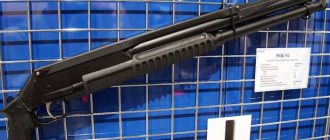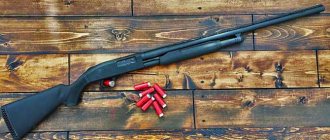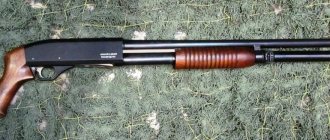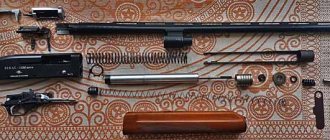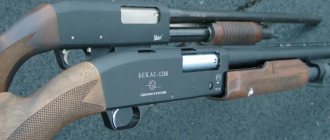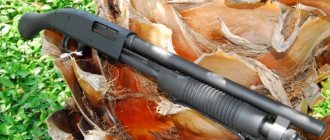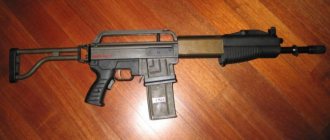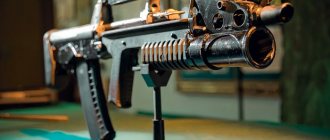The KS 23 shotgun is considered a police weapon, the main purpose of which is to suppress riots through force, psychological and chemical action on troublemakers.
The development of the shotgun began in the 70s, when the need arose for the Ministry of Internal Affairs to use effective non-lethal weapons to suppress mass unrest. Thanks to certain experiments, ammunition with grenades charged with gas was created. Due to the fact that the main requirement for the new shotgun was to accurately hit the target from a distance of one hundred to one hundred and fifty meters, they decided to use rifled barrels. To simplify and reduce the cost of the production process, they were taken from a 23-caliber aircraft gun. KS 23 began to appear in units of the Ministry of Internal Affairs in 1985 and immediately established itself as an excellent model.
1. Special carbine KS-23 2. Special carbine KS-23M with a detachable butt 3. Carbine KS-23 with a special attachment for shooting gas grenades 4. Carbine KS-23M with a device for shooting a grappling hook with a rope (up to 35m and 20m in height) 5. Cartridges with rubber bullets, expelling charges and small-sized gas grenades for KS-23 and KS-23M 6. Combined gas grenade “Cheryomukha-6” 7. Gas grenade of increased power “Cheryomukha-12″ / “Lilac-12”
Description
The KS shotgun (23M, 23K) is a non-automatic pump-action weapon with mechanical reloading due to the fore-end being driven, held by the hand and shifted first back, then forward.
If we consider the KS according to the classifier of small arms, then it cannot be classified in this category. Its caliber exceeds 20 mm and, by standards, is close to that of small artillery. In addition, although a rifled barrel is used, the KS fires ammunition that is similar in design to its counterparts for smooth-bore weapons and has a composite sleeve with a brass bottom and a folder body. In addition to bullets and grenades of the appropriate caliber, the KS is capable of firing charges with buckshot, the caliber corresponding to a 4 mm hunting weapon.
30 mm ammunition for naval artillery systems
These 30-mm ammunition are intended for firing at unarmored or lightly armored ground, sea and air targets from anti-aircraft guns AO-18, AO-18L and AO-18K (6K30GSh, GSh-6-30L and GSh-6-30K), and also automatic guns AK-630 (AK-630M), AK-306 and the Kashtan anti-aircraft artillery complex. The use of a plastic driving device in the shells of these munitions makes it possible to extend the service life of the barrels of naval artillery systems, as well as to rationally use the space for ammunition on the ship. 30 mm ammunition:
- with a high-explosive fragmentation incendiary projectile;
- with a fragmentation tracer projectile.
Design
The magazine of the KS 23 shotgun is tubular, located at the bottom of the barrel, designed for 3 rounds. The safety is in the form of a transverse button, which is located in front of the trigger guard.
The sight is rifle, there is no possibility of adjustment. There is a landing point on the bolt box for installing other accessories.
The stock and butt in the form of a semi-pistol grip are made of wood, and there is also a shock-absorbing butt pad made of rubber material.
For KS 23M carbines, a separate pistol-shaped plastic handle and a removable steel stock are provided. On the muzzle of sample 23M there is space for installing special over-caliber mortars for 36- and 82-caliber grenades.
In the 90s, KS 23 became the main basis for the development of KS 23M (Drozd) and KS 23K, which were smaller in size and considered more suitable for use in small spaces.
The main difference between the KS 23M and the initial model was a removable stock and a shortened barrel, but the KS 23K weapon was distinguished by the presence of a bullpup layout and a detachable box magazine, but only the KS 23M was launched into production.
40 mm rounds with fragmentation grenades for under-barrel grenade launchers
The grenades are designed for firing along a flat or mounted trajectory from under-barrel grenade launchers GP-25, GP-30 and GP-34 mounted on Kalashnikov assault rifles of 7.62 and 5.45 mm calibers (AKM, AKMS, AK-74, AKS-74 , AK-74M, AK-101, AK-103, AM-94) against enemy manpower, as well as military equipment (vehicles, launchers, radar, etc.). This product of NPO Pribor is distinguished by high technical characteristics that ensure reliable destruction of targets in any weather conditions. For firing from under-barrel grenade launchers, two types of ammunition are used: the VOG-25 fragmentation grenade and the VOG-25P “bouncing” fragmentation grenade, which, when it hits an obstacle, jumps up and explodes in the air at a height of 0.5-1.5 meters.
Ammunition
For the shotgun, a wide range of 23-caliber ammunition has been developed with different types of action: with rubber and plastic bullets, buckshot or inert charges used in training, with containers filled with chemical gas, blank charges, with the help of which locks are shot and special grenades are thrown. . Attempts were made to expand the capabilities of the carbine by creating cartridges with lead or steel bullets and buckshot. The end results exceeded all expectations, but at the same time, the exceptional efficiency of the shotgun was accompanied by significant recoil force.
The main list of ammunition for the KS 23 carbine consists of the following types of cartridges:
- 23 mm – blank charge, intended for throwing an over-caliber grenade;
- cartridge "Barricade" - loaded with a steel bullet. The main purpose is to destroy major transport hubs to cause a stop. Such charges are fired at the wheelbase and engine;
- Volna-R ammunition is a traumatic cartridge with a bullet made of rubber material. As stated in the instructions of the Ministry of Internal Affairs, the use of such cartridges at a distance of less than forty meters is prohibited due to the likelihood of causing serious injuries. Maximum firing efficiency – up to seventy meters;
- charges "Cheryomukha-7M" and "Siren-7" - a gas grenade capable of flying one hundred and fifty meters;
- “Star” is a light and sound grenade that produces a shock effect;
- “Shrapnel-10 (25)” cartridges – buckshot charges, the index of which indicates at what range the use will be most effective;
- "Cheryomukha-6" 32 caliber - a gas grenade for a muzzle mortar, fired with a blank charge. The maximum firing range is up to two hundred meters;
- "Cheryomukha-12" 82 caliber is a gas charge of increased efficiency, recommended for use in open areas. It is fired at one hundred and twenty meters with a blank cartridge placed in a muzzle mortar.
23 mm aircraft cannon ammunition
Ammunition of this type is fired from 23-mm aircraft guns AM-23, GSh-23, GSh-6-23 and GSh-6-23M to destroy ground and air targets. The ammunition has high characteristics, ensuring reliable and long-lasting operation of the assault rifles in all weather conditions. 23 mm ammunition:
- with a high-explosive fragmentation incendiary projectile;
- with an anti-aircraft high-explosive incendiary projectile;
- with a projectile with ready-made submunitions;
- with an armor-piercing incendiary tracer projectile.
The high-explosive incendiary projectile and tracer high-explosive incendiary projectile are equipped with an all-weather igniter capsule with a delayed-action fuse. The armor-piercing tracer projectile and the armor-piercing incendiary tracer projectile are designed to destroy lightly armored ground and air targets.
Advantages and disadvantages
The KS 23 is considered by many to be a capricious weapon and quite inconvenient, and unsuitable for rapid shooting. This is due to the strong recoil and tight movement of the forend, due to which reloading is performed. By the way, strong recoil can cause damage to the shotgun itself.
If you assemble the weapon incorrectly and disturb the installation of the firing pin, the shot will not fire. In this case, the trigger striking the firing pin will bend in an arc.
It’s fair to say that certain advantages of the 23-caliber KS shotgun still exist. Like other weapon systems, the shotgun provides for manual loading of ammunition into the chamber. This feature allows you to quickly and quietly charge, and you can feed ammunition of a different type into the barrel.
KS-23K, bullpup design. Never made it into series
30 mm automatic cannon ammunition
Designed to engage both ground and air targets, 30-mm ammunition is used to fire from 2A42 and 2A72 automatic cannons mounted on infantry and airborne combat vehicles BMP-2 and BMP-3, BMD-2 and BMD-3, combat the BRM-3K Lynx reconnaissance vehicle, as well as from the 2A38 anti-aircraft guns of the Tunguska anti-aircraft gun and missile system. In addition, the ammunition of the specified caliber developed by the enterprise is used to fire domestic Ka-50 and Mi-28 helicopters from 2A42 automatic cannons. These products from NPO Pribor have high characteristics that ensure reliable and long-term operation of automatic guns in all weather conditions. 30mm fragmentation ammunition:
- with a high-explosive fragmentation incendiary projectile;
- with a fragmentation tracer projectile.
Ammunition of this type is designed to destroy unarmored and lightly armored ground and air targets, as well as enemy personnel. They use an all-weather igniter capsule with a delayed action fuse and a self-destruct device. In addition, the projectile has several fuses. 30 mm armor-piercing ammunition:
- with an armor-piercing sabot projectile;
- with a solid-body armor-piercing tracer projectile.
Ammunition of this type is designed to destroy lightly armored ground and air targets. An armor-piercing sabot projectile with a separating pan has an active sub-caliber element made of a tungsten-based alloy, has high penetration ability and provides a significant damaging effect after penetrating the armor. An armor-piercing sub-caliber projectile with a core equipped with a tail fin is located inside a cartridge case filled with a powder propellant charge, in the bottom of which an igniter primer with a fire transfer tube is installed. The heavy-alloy core is mounted in an aluminum pan that carries a plastic drive belt and a housing with longitudinal grooves. The pallet is made split, the component sectors of which are additionally fastened with a bandage having bridges of a weakened cross-section, and placed in the annular groove of the central funnel of the front end of the pallet, which is rigidly connected to the heavy-alloy core through a left-hand thread, and through a locking connection to a body made in the form of a thin-walled tip . Communication channels are distributed in the sectors of the pallet, ensuring the penetration of powder gases generated from the combustion of the propellant charge inside the thin-walled tip. The proposed technical solution ensured an increase in the armor penetration of the core of a sub-caliber projectile at long distances and angles of encounter with an obstacle without ricocheting.
Modifications
Over the entire operational period, they were able to determine not only the strengths, but also the weaknesses of the KS 23-caliber shotgun. Users concluded that a sample whose length exceeds one meter due to a massive butt made of wood material does not always help well in operational activities. Security forces asked to provide them with more compact versions, without changing their combat qualities. This is how the Drozd 23M version appeared. The tests were successful, and the weapon was assigned the index KS 23M, beginning its supply to law enforcement agencies.
The main difference of the 23M model was the barrel shortened by ten centimeters. In addition, the new 23M model lacked a wooden stock, which was replaced by a plastic handle and a steel shoulder rest.
At the same time, the 23M shotgun continued to be characterized by a low rate of fire, a small number of charges in the magazine, and the inability to quickly change the type of ammunition used.
But the KS 23K version is free of such shortcomings and is a completely updated weapon. This is a bullpup carbine, in which the handle is located in front of the magazine. The 23K detachable box magazine holds up to seven rounds.
Some experts believe that such a decision was intended not only to increase the magazine volume of the 23K product, but also made it possible to quickly replace the ammunition used with a magazine with other ammunition.
The KS 23K shotgun uses a flag-type safety, shifted to the left side and located near the pistol-shaped handle. The window of the 23K gun, through which spent cartridges are ejected, is covered with a plate that opens only at the time of reloading. The 23K shotgun now has a sight stand that functions as a handle when carried.
Special carbine KS-23M with a set of attachments and Cheryomukha-6 grenades
Special carbine KS-23
KS-23 (23 mm special carbine) is a multifunctional weapon for arming police units. Used to suppress riots, selective mental, chemical or forceful influence on violators of public order. It is a non-automatic pump-action shotgun, that is, it is reloaded mechanically, by moving the fore-end with the hand holding it, first back and then forward. Work on the creation of this shotgun began back in the 1970s; it was developed by order of the USSR Ministry of Internal Affairs. The terms of reference for the creation of a special carbine were formulated by designers and engineers from TsNIITochmash and the Research Institute of Special Equipment of the Ministry of Internal Affairs. That is, the best personnel of the state worked on it. The new carbine was assigned the following tasks: supporting assault teams in detaining especially dangerous criminals, suppressing mass protests with minimal damage to citizens (as an effective non-lethal weapon), as well as conducting counter-terrorism operations (although in those years there was no such formulation yet). The new weapon was conceived as a purely police weapon, and its use had to be quite flexible.
The new product entered service only in 1985, and to this day various KS-23 carbines are in service with law enforcement units of the Russian Federation and a number of post-Soviet countries. It is not for nothing that the name of this carbine contains the letter “C”, revealing its special component. The weapon is truly special and specific, this lies in the caliber, barrel design, and types of ammunition used, which allow for great tactical flexibility in the use of the KS-23.
KS-23 and KS-23M "Drozd"
The problem with this weapon is that, according to the GOST classification generally accepted in our country, this carbine is an artillery weapon, since it has a caliber of more than 20 mm. In principle, on the market you can find guns of the fourth (hunting) caliber (“goose guns” or “shotguns”), which are usually used for shooting at flocks of wild birds; their nominal caliber is 23.75 mm. By the way, it was on the basis of a fourth-caliber hunting cartridge that at one time in our country a 26-mm cartridge was developed, intended for Shpagin’s signal pistol. And only then, on the basis of this cartridge, ammunition was developed for the special KS-23 carbine. This raises the question, why are the calibers different? The answer to this is quite simple - the KS-23 uses a rifled barrel, these riflings “eat up” 3 mm.
The approach using a rifled barrel is completely justified. The carbine was made to be rifled so that it could provide the required accuracy of fire. The fact is that representatives of the Ministry of Internal Affairs demanded that Soviet designers develop a carbine with such accuracy that it would be possible to get into a small airliner window even from a relatively long distance. The designers realized that this problem simply could not be solved without using a rifled barrel. Another fact is of interest. The barrels for the KS-23 carbine are the barrels of automatic 23-mm aircraft guns shortened and machined on the outside (to reduce weight). This is an original solution that simplifies production and reduces the cost of the product. The barrel of the KS-23 was locked by turning the bolt to 4 radial lugs. The total length of the barrel was 510 mm, and the length of its rifled part was 410 mm; there were a total of 10 grooves in the barrel.
KS-23M "Drozd"
Almost immediately after the KS-23 carbine was put into service, work began on its modernized version KS-23M, code of work “Drozd”. It was developed to arm the police and units of the internal troops of the Russian Federation. The modernized version was created on the basis of the KS-23, work began in October 1990. At first the new carbines were known as the S-3. The first batch of 25 such S-3 carbines was handed over for testing on December 10, 1991, after which the carbine was renamed from S-3 to KS-23M “Drozd”. The carbine successfully passed tests and was adopted by the police and the Internal Troops of the Russian Ministry of Internal Affairs.
The KS-23M carbine is not automatic. The reloading mechanics of this carbine work the same way as a pump-action shotgun - from a longitudinally sliding fore-end, which is rigidly connected to the bolt. The carbine was fed with cartridges from a tubular magazine designed to hold 3 rounds; the magazine was located under the barrel of the weapon. The carbine used a hammer-type trigger mechanism. When fired, the barrel bore was locked by turning the bolt cylinder. The entire range of ammunition that was created for the KS-23 could be used to fire this weapon. In addition, on the KS-23M it became possible to install barrel attachments “Nozzle-12” and “Nozzle-6”.
“Nozzle-6” is designed to fire “Cheryomukha-6” grenades with a diameter of 36 mm at a range of up to 200 meters. This grenade releases up to 60 cubic meters of CN gas. Moreover, these grenades can be used as hand grenades. “Nozzle-12” is designed to fire “Cheryomukha-12” grenades with a diameter of 82 mm at a range of up to 120 meters. Such a grenade releases up to 100 cubic meters of CN gas. Also, with the KS-23M carbine, the OTs-06 “Cat” attachment could be used, which is designed to throw a grappling hook to a height of the 7th floor at a distance of up to 35 meters.
The KS-23M carbine used an open sight, not adjustable. The stock on it was replaced with a T-shaped shoulder rest. In addition, a pistol grip appeared on the weapon. The handguard and pistol grip were made of plastic. Despite the fact that the KS-23M Drozd had more compact dimensions compared to its predecessor, it did not solve the main problem that was inherent in the design of the carbine with a tubular magazine. We are talking about the impossibility of quickly changing the type of ammunition used (for example, you would need to quickly replace a cartridge with a rubber bullet with a cartridge with gas). This problem was solved only in the KS-23K carbine.
KS-23K
If a carbine with the letter “M” in the name can be safely considered a modernization of the basic model, then the model with the letter “K” is a completely different weapon. The motives of its creators, who retained the old name, replacing only the letter, are not entirely clear. Yes, the weapons still have the same goals, there is common ammunition and the same parts in the design, but otherwise there are striking differences. So the KS-23K is a carbine that is built according to the bullpup design. That is, the control handle is located in front of the store. Moreover, unlike the first two models, power is supplied from a detachable box magazine designed for 7 rounds. A number of experts believe that this decision was intended not only to increase the magazine capacity, but also to provide the ability to quickly change the ammunition used. You can always exchange a magazine with one type of ammunition for a magazine with another.
The KS-23K carbine uses a safety lever, which was moved to the left side of the weapon and located next to the pistol grip. The window for ejecting spent cartridges was covered with a special plate, which opened only at the moment of reloading the weapon. In addition, a sight stand has appeared, which also serves as a handle for carrying the carbine.
KS-23K
Ammunition for KS-23
The basis for the versatility of the special KS-23 carbine was the wide range of ammunition used. It was possible to use both ordinary fourth-caliber hunting cartridges (shotguns), as well as specially created ammunition and self-loaded cartridges from the SPS signal pistol.
Ammo used:
“Volna” is a cartridge with inert ammunition for training shooting.
"Volna-R" is a cartridge equipped with a traumatic rubber bullet. Effective when shooting at a distance of up to 70 meters. However, it has limitations: it is prohibited to shoot such cartridges closer than 40 meters. At such a distance there is a possibility of causing serious injuries, which can even lead to death.
"Strela-3" is a cartridge equipped with a plastic traumatic bullet.
“Zvezda” is a light and sound cartridge.
"Cheryomukha-7" - a cartridge equipped with CN tear gas, has a firing range of 150 meters. Capable of producing a gas cloud of 30 cubic meters in an unbearable con, it is a modernized version of the previous cartridge, which has an increased volume of tear gas released to 50 cubic meters.
"Lilac-7" - a cartridge filled with CS tear gas, compared to CN, is more effective against citizens who are intoxicated. The firing range of such a cartridge is 100 meters, the volume of CS gas released is 50 cubic meters.
"Shrapnel-10" is a cartridge equipped with a buckshot charge with an effective firing range of 10 meters.
"Shrapnel-25" is a cartridge equipped with a buckshot charge with an effective firing range of 25 meters (reinforced charge).
"Barricade" is a cartridge equipped with a pointed steel bullet. Originally intended to stop vehicles by damaging the engine. But, naturally, it can be used as a lethal ammunition, as well as an armor-piercing weapon.
Blank cartridge - used for a stunning sound effect, as well as for firing with special muzzle attachments.
Sources of information: https://world.guns.ru/shotgun/rus/ks-23-r.html https://ohrana.ru/weapon/valve/36666 https://gunsite.narod.ru/ks23m.htm
4 gauge cartridges
During the production of the gun and for several years after it was removed from the production line for the "Drake" at the Tula arms plant, TsNIITochmash produced factory-made 4-caliber cartridges that had a charge of Sokol gunpowder of 3.9 grams and shot - 47 grams. And this, I must say, may surprise you - why have such a large caliber and all the difficulties that accompany it (in the form of the heaviness of the gun and the scarcity of ammunition), if an ordinary magnum cartridge of the most popular 12-gauge shoots a shot charge of 48 grams?
© wikipedia.com
However, the thickness of the walls of the “Drake” chamber is 5 mm, and, according to the owners, in practice the gun can easily withstand up to 65–70 grams of shot, which to some extent justifies its meaning as a “duck gun” when a hunter loads cartridges on his own. Moreover, independent equipment is the only thing left for the owners of the “Drake”, because today cartridges for it are not produced and are not on sale.
But making your own equipment is not as easy as it seems. There is nothing on the official sale for home assembly of 4-caliber cartridges - no shells, no wad containers, no accessories. The owner of a gun can only buy gunpowder, shot and capsules... Therefore, the savvy owners of the Drakes use for them cardboard cartridges from 4-caliber flare guns (which are still produced, sold and have a standard capsule that can be replaced) and even use them with a small modification... aluminum casings from aircraft anti-missile systems - infrared decoys.
The fact is that these systems use cassettes loaded with dozens of 4-caliber cartridges with an electric primer, from which an airplane or helicopter shoots dozens of burning pyrotechnic bombs into the air. This is done in order to interfere with homing missiles with thermal guidance systems. In the spent cartridges, the electric primer is removed and a bushing is installed at home, into which a standard primer, such as “Zhevelo” or “KV”, sold in hunting stores, is pressed. Such is the reforging of “military swords” into hunting “ploughshares”...
oNMЪB OEPYAOEIRKHBMNYARE YAUELSH YUBRNLYURKHYH, OPEDKNFEMNI mHYNKYUEL lHUYUIKNBHVEL yuTYUYUYAEEEBSHL, MYUVYUKEMHY zhya-14, RYUKYUMRKHBSHI KHMFEMEP X NPTsYUMHGYURNP hTSNPE TEDNP NBHV dLKHRPHEB, ME DNFKHDUJYAE NYNMVYUREKEMNI NRPYUANRYH YAYNPNYARPEKEMNTSN OSKEL╦RYU, YHPNYN PUGBEBPMSK PYUANRSH ON YANGDYUMKHCH MU AYUGE YAUELSH yuTYUMYAYEEBU MEYAINKEIKH U YAYNPNYARPEKEMSHU YUBKHYUZHNMMSHU X GEMKHRMSHU AXIS YUKHAPU 20, 23, 30 X 37 LL. dK SCHRNTSN, YPNLE mHYNKYU lHUYUIKNBHVYU, Y PUANRYUL ASHKH OPHBKEVEMSH KHGBEYARMSHE BSHYANYNYBYUKHTHZHHPNBUMMSHE YNMYARPSYRNPSH-NPSFEIMKHYH o. c. YYSYEB, Yu. Yu. bNKYNB, me. Yu. ъPRZHEB, c. X. mHYHRHM, yu. Yu. aSKYHM. MYUKHANKEEEE BMHLYUMKHE SDEKKNYAE YANGDYUMKHCH 23-LL OSYKH OND OYURPNMSH b (BEDSYKH YNMYARPSYRNP m. l. yuTYUMYAEEB) X mya-23 (BEDSYKHE YNMYARPSYRNPSH m. l. yuTYu MYYAEEEB X m. t. lYYYUPNB). OPH SCHRNL NYAMNBMYU YARYUBYU DEKYUKYUYAE MU OSYS OND OURRPNM b, NOSHRMSHY NAPYUGEZH YNRNPNI OND KHMDEYANL ria-494 ASHK PYUGPYUANRYUM Y KERS 1949 Ts. H SFE B YNMZHE TSNDU ASHK Y NAPYUM. OSYU PUANRYUKYU MYUD╦FMN, SBEPEMMN BSHDUBUYU RELO YARPEKEASH 1100 BSHYARP./LHM. BYAKED GYU MEI ASHK PYUGPYUANRYUM X HGTSNRNBKEM NOSHRMSHI NAPYUGEZH OSYKH RYA-495 OND OURRPNM my.GDEYAE YAKEDSER YADEKURE NRYARSOKEMHE, ONYAM'CHYE YAKNFMNYARE OPNAKELSH. OSYU b-23, SYARYUMYUBKKHBUELYU BN BPEL BEKKHYNI nREVEYARBEMMNI BNIMSH MU URSPPLNBKHYE xK-2, LNTSKYU SYAOEMN ONPUFYURE bHPNYSCH TSYULLS ZHEKEY, B RNL VHYAKE RYUMYKH YABEPUS . gMYUVHREKEMSHE TSYUAYUPHRSH OSYKH DEKYUKH MEBNGLNFMSHL E╦ LNMRYUF B PUGBYUKE ZHKHMDPNB DBKHTSUREK KHKH PJDNL I MHL (RPYUDHZHNMMSHE LEYARYU PYUGLEYEMH OSIY MU HYA RPEAHREKU), BSHYANYU SHMEPTsKH NRDYUVH YASYYYARBEMMN BKKHKYU MU SYARNIVKHBNYARE YAYULNK╦RYU B ONK╦RE. I DPSTSNI YARNPNMSH, OPNAKELYU ONBSHYEMKH LNTSSYYARBU OSEVMNTSN BNNPSFEMKH HYARPEAHREKEY SFE YARNKYU, YUY TSNBNPKHRYA, “BN BEYAE PNAR” — YAYNPNYARKH YAYULNK╦RN B MEOPEPSHBMN PNYAKH, ME GYU TsNPYULH ASHK ╚BSHUND B YABER╩ PEYURKHBMNI YUBKHYUZHKH. MENAUNDHLNYARE ONBSHYEMKH NTSMEBNI OPNKHGBNDHREKEMNYARH DKHYRNBUKYU DBY OSRKH PEYEMKH OPNAKELSH.
oEPBSHI OSRE YANYARNK B SBEKHVEMXX YAYNPNYARPEKEMNYARKH. MN BNGLNFMNYARKH ON ETSN PEYUKKHYUZHKH MU AYUGE YKYUYAYAHVEYAYHU YAUEL YUBRNLYURKHYH YINMZHS 1940-U TsNDNB ASHKH OPIURKHVEYAYKH HYAVEPOYUMSH, KH NDMNI KH OPHVKHM SCHRNTSN ASHKH O YUPYULERPSH YASYYYARBSCHYKHU OSYEVMSHU ANEOKHOYUYANB. ME YAVKHRYU SYARYUPEBYETSN OYURPNMY Y 20-LL OSYE bby, MUHANKEE UNDNBSHL B YUBKHYUZHKH ASHK OYURPNM Y 23-LL OSYE b, NAKYUDYUBKHI GMYUVHREKEMSHLH TSYUAYUPHRYULH (DKHMYU 237 LL) X HLOSKEYANL NRDYUVH. ONBSHYEMKHE YAYNPNYARPEKEMNYARKH OSYKH, ONYARPNEMNI ON NASHVMNI YAUELE, OND OYURPNM b, YAYULN ON YAAE OPEDYARYUBKKN YAPE╦GMSCH OPNAKELS. BEKKHVKHMYU UNDU ONDBHFMSHU VYUAREI, YANARYUBKBIU B ShchRNL YAKSVIUE ME LEMEE DKKHMSH OURPNMY, ME DYu╦R SLEMEKHRE BPEL ZHKYU PUANRSH YUBRNLYURKHYKH AEG ONBSHYEMKH YAYNPN YAREI DNYARYURNVMN LYUYAYAHBMSHU GBEMEEB, YU GMYuVHR BED╦Y SLEMEYEMHCH KHU FHBSVEYARKH OPH MEHGAEFMSHU YANSDYUPEMKHU. MN DUFE EYAKH RUYNE SBEKHVEMKHE RELOYU ASDER DNYARKHTSMSRN, RN YAHKNBNE BNGDEIYARBHE MU SYARYUMNBYS EY╦ ANKEE BNGPUYARER, SUSDYU K╦RMSHE YUVEYARBU YAYULNK╦RYU.
BrNPNI OSRE YANYARNK B YANGDYUMKHH MNBNTsN 23-LL OYURPNMY SLEMEEMMNI LNYNYARKH, GYU YAV╦R VETSN LNFMN ASHKN YANYPYURKHRE TSYUAYUPHRSH X LYuYAS YUY OSYKH, RYU X OYURPNMY Y MEI YAN GBEMNL KEMRSH (YU GMYuVHR X LYUYAAS ANEINLOKEYRYU), SLEMEHRE BKKHMHE BSHYARPEKYU MY DHMYULHYS ONK╦ RYU KERYUREKEMNTSN YOOYUPYURYU. gyu YAV╦R YASCHYNMNLKEMNI LYuYAYASH NPSFKH LEME'KHU OPNDNKEMShu TSYUAYUPHRNB OYURPNMYU LNFMN ASHKN NAEYAOEVHRE ONBSHYEMKHE RELOYU YARPEKEASH NPSFKH KHKH, MUOPHLEP, B YUVEYARBE B PELEMMNI LEPSH, ONYU RUYNE NPSFHE ME PYUGPYUANRYUMN, SYARYUMNBHRE MU YAYULNKERE DNONKMHREKEMSHE OSYKH, KH BY╦ SCHRN BLEYARE - AEG SBEKHVEMKH METSYURKHBMNTSN BKHJMKH NRDYUVH MU DHMYULHYS ONK╦RYU YAYULNK╦RYU OPH SBEKHVHBYELYA ANEINLOKEIRE. OPH SCHRNL, YNMEVMN, SLEMEYUERYA MYUVYUKEMYU YAYNPNYARE YAMYUPDU, YU GMYUVHR ETSN DEYARBHE ON GYUYKHY╦MMSHL ZHEKL, YAMKHFUERYA BEPNЪRMNYARE ONPYUFEMH ZHEKH NVE PEDECH HG NDMNI OSYKH, MN ONBSHYEMKHE YAYNPNYARPEKEMNYARKH YNLOKEYAMNI SYARYUMNBYKH B GMYUVKHREKEMNI YAREOEEMKH YNLOEMYAHPSER SHHRKH MEDNRYURYKH. ON RUYNLS OSRH ONKKH YNMYARPSYRNPSH nya-16, B 1943 TsNDS YANGDUB H ONYARYUBHB MU BNNPSFEMKHE B NYRYAPE 1944 TsNDYu MNBSHI LYUKNTSYuAYUPKHRMSHI 23-LL OYURPNM (DKHMYU OYUR PNMYU 200 LL) I SLEMEEMNI MUVYUKEMNI YAYNPNYARECH Y OSJE m-23. oPHLEMEMKHE SCHRNTSN OYURPNMY ONMKHFEMMNI AYUKKHYARKHYKH ONGBNKHKN MU 44% YAMKHGHRE LYUYAYAS OSYKH ON NRMNYEMHCH Y OSYE b OPH OPUYRKHVEYAYKH NDKHMYYINBNI I ONYAKEDMEI NTSMEBNI OPNHGBNDHREKEMNYARKH. ONEBKEMKHE K╦TSYNI OSYKH mya-23 ONGBNKKHKN SYARYUMNBHRE MU KHYARPEAHREKE kYu-9 VERSHPE RUYKHE YAHMUPNMMSHE OSYKH!
ndMUYN BNOPNYA YANGDIUMKH YAYNPNYARPEKEMSHU YUBKHYUZHNMMSHU AXIS OND LNYMSHI OURRPNM b ME ASHK YAMIR. DEKN B RNL, VRN OYURPNM my I SLEMEEMMNNI YAYNPNYARECH YAMYUPYUPYU ЪBHKYA B GMYUVHREKEMNI YAREOEEMH OKNDNL DUKANE MENDMNGMYUVMNTSN YNLOPNLHYAYU LEFDS VYUARN BGYUHLNHYAYK CHVYUCHYHLH GUOPNYYULH YUBHYURNPNB KH PYUGPYUANRVKHYULH YUBKHYUZHNMMNTsN BNNPSFEMHЪ. x ME BYAE RNTSDU B mYUPYNLURE BNNPSFEMKH ONKNFHREKEMN BNYaOPKHMKKH KHDECH OPHLEMEMEKH OURPNMYU SLEMEEMNI LNYNYARKH. DYUKEMEEEE PUGBHRKHE YANASHRKHI ONDRBEPDKHKN PJD NOYUYAYEMKHI. YuBKHYUZHKHH, B OEPBSCH NVEPEDE NANPNMHREKEMSHL SYARYUMNBYUL ANLAYUPDHPNBYKHYNB, MSFMSH ASHKKH OSYKH, YNRNPSHE LNTSKKH ASH BYARPEVIURE NTsM╦L YAYNPNYARMSHE PEYURKHBMSHE HYARP EAHREKH MU DUKEMNYARYU, OPEBSHYUCHYKHU DUKEMNYARE SHTTEYRKHBMNI YARPEKEASH KH OSIEVMSHU SYARYUMNBNY. b OPNRKHBMNL YAKSVUE ONPUFEMKHE ANLAYUPKHPNBIKHYU ASHKN OPYURKHVEYAYKH MEHGAEFMSHL. ONSCHRNLS d.t. NOTHING B.
b OPNZHEAYAYE DNPUANRNY 23-LL AXIS (rya-494 X rya-495) ASHK BSHIBKEM MNBSHI SHTTEIR. NYYUGYUKNYAE, VRN OPH BSHYANYKHU YAYNPNYARU OPHUNDU LYUYAYAHBMSHU ONDBHFMSHU VYUYAREI B YPYUIMEE GYUDMEE ONKNFEMKHE, RPYUDKHZHNMMSHI OPSFKHMMSHI ASTEP OPEYARYUK NOPYUBDSHBURE I EAЪ KhG-GYU ANKEKHU ONREPE SHCHMEPTSKHH B OPSFKHME, YU RUYFE BYAKEDYARBHE MEDNYARYURNVMNI FHBSVEYARKH ONYAKEDMEI. sDNBKERBNPHREKEMNE PEEMKHE OPNAKELSH OPEDKNFHK mHYNKYUI TEDNPNBHV LYuYUPNB, KHGBEYARMSHI YNMYARPSYRNP 9-LL OKHYARNKERYU ol. bGYULEM RPYUDKHZHNMMNTSN OPSFKHMMNTSN NM YAYNMYARPSKHPNBUK B GYURSHKEMHYE TSYUGNBSHY ASTEP OSYKH I BSHYANYHLH SCHMEPTSERHVEYAYHLH YUPYYREPHYARKHYULH. TsYUG DK ETSN TSMYZHNMHPNBYUMH NRBNDHKYA KH TSYUGNBNI YULNPSH NPSFKH ON YAOEZHHYUKEMNLS TSYUGNOPNBNDS, VRN ME YAYUGSHBYUKNYAE MU BMSRPEMMEI AYUKKHYARHYE BSHYARPEKYU. schryu YNMYARPSYZHKH NAEYAOEVHKYU MENAUNDHLSCH FHBSVEYARE ASTEPMNTSN SGKYU OPH BSHYANYKHU YAYNPNYARU NRYURYU ONDBHFMSHU VYUYAREI. nDMuYN YNSHTTHZHEMR BNYAYARYUMNBKEMKH TSYUGNBNTsN ASTEPU NASYAKNBHK MEDNYARYURNVMN SHMEPTSKHVMSHI MUYUR ONDBHFMSHU VYUYAREI. ONSCHRNLS m. t. YARBN H DK SYAYNPEMKH MUYURYU ONDBHFMSHU VYUYAREI.
naE OSYH ASHKH NYAMYYEMSH OPSFHMMMSHLH YULNPRKHGYURNPYULH NRYYURYU, SLEMEYUBHLH BNGDEYARBHE NRDYUVH MY SYARYUMNBYS. uYUPYUREPHYARKHYH YULNPRKHGYURNPNB ASHKH YANTSKYUYANBYUMSH I OYUPYULERPYULH DBHFEMKH KGDEKH B NRYYURE KH MUYURE. ShRYU PUANRYU ASHKYU OPNBEDEMYU zhya-14 MU BSHIANYNL MYUSVMNL H REUMHVEYAYNL SPNBME, VRN ONGBNKHKN AEG DNONKMHREKEMNTSN ╚PYUGTSNMYU╩ YAYULNI OSYKH, RNKEIN GYU YAV╦R NOR HLKHYUZHKH OYUPYULERPNB YULNPRKHGYURNPNB, ONBSHYAHRE RELO YARPEKEASH S OSYKH RYA-495 ONVRKH MU 100 BSHYARP./LHM.
UYUPYUREPMNI NYNAEMMNYARECH NAEKHU AXIS ЪБКЪРЯК ПУГЛОПЪМХе ЦУГННРБНДМНЦН DBХЦУ reКЪ YUBRNLYURKHYH BAKHGH NR YAMYUPЪDMNTSN BUNDYU YARBNKYU. RUINE PE'EMKHE OPNDKHIRNBYUMN YARPELKEMHEL SAPYURE BMSRPE AYUMH TSYUGNNRBNDMSCH YAKHYARELS, KHLECHYSCH GMYUVHREKEMSHI ONOEPEVMSHI TSYUUPHR, I ZHEKECH SLEMEYEMKH YANOPNRKHBKEMKH MYUAE TSYUCHIYELS ONRNYS BNGDSUYU OPH YARPEKEAE ONOEPEY YSPYYU YAYULNKERYU. yPNLE RNTsN, YNMZHEMRPYUZHKH LYUYAYA VYUYAREI OSYKH BAKHGH E╦ ZHEMRPYU RFFEYARKH SLEMEWER LNLEMR KHMEPZHKH KHDEKH, VRN, B YABNCH NVEPEDE, ONGBNKYER SBEKKHVKHRE YAYNPNYARKH OEPEAPNYU SYARYUMNBYH X SLEMEHRE RPEASCHYSCHYA DK SCHRNTSN LYMNNYARE OPHBNDU. ONYAKEDMEE OBKKERYA NDKHMUINBN ZHEMSHL KH DK MUGELMSHU GEMKHRMSH SYARYUMNBNY.
b 1951 TsNDS NAE OSYKH - rya-494 X rya-495 SIAOOEMN OPNKKH TSNYASDYUPYARBEMMSHE MUGELMSHE HYAOSHRYUMKH, Y OSYU rya-495 OPNKYU X K╦RMSHE TSNYASDYUPYARBEMMSHE HYAOSHRYUMKH Kommersant 20 AXES RYA-495 ASHKKH SYARYUMNBKEMSH MU PUGKKHVMSHU YAYULNKERYUU. b SYAKNBKHU ONK╦RYU XG SHCHRKHU AXIS OPNKHGBEKH NYNKN 150 RSHYA. BSHYARPEKNB, OPH SHRNL GYUDEPFEY ON BHME OSYKH NRLEVMN ME ASHKN. b OPNZHEAYAYE HYAOSHRYUMKHI OSYKH rya-494 OND OYURPNM b BSHYAMHKNYAE, VRN NMY NYASYYYARBKJER MUYARNKEIN LNYMNE YAHKNBNE BNGDEIARBHE MU SYARYUMNBYS, VRN YNMYARPSYZHK YYULNK ERYU ME BSHDEPFKHBUER H DETNPLHPSERYA (YAPSHBUCHRYA GYIKEOYKH). YARYUKN NVEBKHDMSHL, VRN OSYS OND OYURPNM b MEKEG HYAONKEGNBURE B YASYYYARBSCHYKHU ONDBHFMSHU SYARYUMNBYUU.
nDMNBPELEMMN I NRPYUANRYNI OSYKH rya-495 ASHK SYANBEPEMYARBNBYUM OYURPNM mya-23 Y MEI B VYYARKH ONBSHYEMKH SHTTEIRKHBMNYARKH ONPUFUYUCHYETSN DEYARBHЪ X BBEDEMKH TKETSL YURKHGKHPNBUMMNTSN LYUKNSCHPPNGHNMMNTSN OPNTSPEYAYAKHBMNTSN ONPNUYU DK ONBSHYEMKH FHBSVEYARKH YARBNKYU. sYANBEPEMYARBNBUMMSHHI OYURPNM YARYUK MYUGSHBUREYA ul-23. schRNR OYURPNM BGYUHLNGYULEMYEL I OYURPNMNL mya-23, MN ONYAKEDMKHI DYUBMN ME OPNHGBNDHRYA.
b LYUE 1954 TSNDYU YUBHYUZHNMMYU OSYU rya-495 YNMYARPSYZHHH m.l. yuTYUMYAYEEEBYU X m. t. ASHKYU OPKHMURYU MU BNNPSFEMHE YUBKHYUZHHH OND MYUHLEMNBYUMHEL yul-23.
yuBRNLYURHVEYYU OSYU yul-23 OPNHGBNDHKYUYAE MU rSKEYAYNL LYUHMNYARPNHREKEMNL GYUBNDE HL. p'AKHYNBU I 1954 TsNDYU ON 1972 TsND, R. E. MU OPNRЪFEMKHH 18 KER I BSHOSYAYNL B NRDEKEMSHE TsNDSH DN 10000 LR. B CND. nMYU ЪБКЪКУЯЭ НЯМНБМШЛ NAPYUGZHL OSEVMNTSN NANPNMHREKEMNTSN BNNPSFEMKH NREVEYARBEMMNI YUBHYUZHHH. eI B PYUGMSHE TsNDSH BNNPSFYUKHYAE YYULNK╦RSh rS-16, rS-95, l-3, aE-8, aE-10, yuM-8, yuM-10. b 1967 TsNDS GYU PYUGPUANRYS ŠHRNI OSYYH m.l. yuTYUMYYAEEEB X m.t.
pYUANRSH ON OSYE rya-494 OND OURRPNM b ME OPNOYUKH. hLE ANKEE BSHYANYSCH MYUVYUKEMSCH YAYNPNYARE YAMYUPYUDYU, SHRYU OSYU MUHANKEE ONKMN ONDUNDHKYU MU PNKE GEMHRMNTSN YAPEDYARBU. b 1953 TsNDS B zhya-14 ASHKH MYUVYURSH PUANRSH ON YANGYUMKHCH DBSU GEMKHRMSHU YUBRNLYURHVEYAYHU AXIS (GEMKHRMSHU YUBRNLYURNB) rya-507 X rya-507f - DKЪ K╦TSYNI ASYAHPSELNI YAOYUP EMMNI GEMKHRMNI SYARYUMNBYKH (gs) X DK GEMKHRMNI YAYULNUNDMNI SYARYUMNBYKH (gyas).
yUBRNLYURSH OPEDMYUGMYUVYUKHYAE DK ANPEASH I YAYULNK╦RYULH OPNRKHBMKHYU MU BSHIANRYU DN 1500 L OPH MUYKNMMSHU DUKEMNYARU DN 2500 L, Yu RUYFE DK ONPUFEMH KETSY NAPNMHPNBUMMSHU ZHEKEY X FHBNI YAKSH, X GDEYAE OURRPNM b ONDUNDHK KSVIE BYAETSN.
pYUGPYUANRYU GEMKHRMSHU YUBRNLYURNB rya-507 X rya-507f OPNHGBNDHKYUYAE OND REUMHVEYAYHL PSYNBNDYARBNL m.l. YuYYYYYYYYYYYYYYYYYYYYYYYU BEDSYKHL ON HU NRPYUANRYE ASHK oERP tsepyuyahlnbkhv ysyeb. nRKHVKHREKEMNI NYNAEMMNNYARECH YUBRNLYURYU rya-507 ASHKN MYUKHVKHE DBSU ASHYARPNYAZ╦LMSHU BGYUKHLNGYULEMYELSHU YARBNKNB I OKYULETSYUYAHREKLKH, LEUUMKHVEYAYNTSN YAOSYAYNBNTSN LEUYU MHGLYU YAN YAOEZHYUKEMSHL AKNYHPSCHYHL SYARPNYARBNL, AKYUTSNDYUP VELS MU ONYAKEDMEL ANEBNL OYURPNME B KEMRE, DNYAKYUMMNL B OYURPNMMKHY, BSHYARPEK ME OPNHYAUNDKHK, VRN ONGBNKKKN OPNHGBNDHRE NRYPSHRHE NTsM AEG OPEDBYUPHREKEMNI OPEGYUPYDYH . nRKHVHREKEMNI NYNAEMMNNYARECH YUBRNLYURYU rya-507f ЪBKЪKNYAE MYUKHVKHE YARBNKYU I FKHDNYARMSHL NUKYUFDEMHEL DK NAEYAOEVEMKH KHMREMYAKHBMNTSN PEFKHLYU YARPEKEASH; MUKKHVKHE SHKEYRPNYAOSYAYU I DYURVKHYULH OHPNOPEGYUPЪDYKH DKЪ DKHYURUMZHNMMNTSN SOPYUBKEMKH NTSM╦L.
dK NANKHU YUBRNLYURNB ASHKYU OPNBEDEMYU LNDEPMKHYUZHKH OYURPNMY OSYKH b - MU ECN AYUGE ASHKH PYUGPYUANRYUMSH OYURPNMSH I ntgr YAMYUPDNL I BGPSHBUREKEL GYULEDKEMNTSN DEIYARBKH Kommersant lts-25 I YAYULNKHYBKHYUZHHEI X I ar YAMYUPDNL B YARYUKEMNI TSHKEGE.
b LUPRE 1960 TSNDYU BNNPSFEMHE YANBERYAYNI yuPLHH ASHK OPHMIR 23-LL GEMKHRMSHI YUBRNLYUR rya-507 I KHMDEYANL 2yu14 YNMYARPSYZHHH m.l. YuTYUMYYYYYYYYYYYYYYYYYYYYYYYYYYYYYYYYYYYYYYYYYYYYYYYYYYYYYYYYYYYYYYYYYU H o. c. YYSYEBYU B YANYARYUBE ASYAHPSELNI GEMKHRMNI SYARYUMNBYKH gs-23. b YAEMRYAPE 1962 TsNDYU MU BNNPSFEMHE YANBERYAYNI yuPLHH ASHK OPHMIR 23-LL GEMKHRMSHI YUBRNLYUR rya-507f I KHMDEYANL 2yu7 YNMYARPSYZHHH m.l. YuTYUMYYYYYYYYYYYYYYYYYYYYYYYYYYYYYYYYYYYYYYYYYYYYYYYYYYYYYYYYYYYYYYYYYU H o. ts.YSYEBYU B YANYARYUBE GEMKHRMNI YAYULNUNDMNI YAVERBEP╦MMNI SYARYUMNBYKH gyas-23-4 “bHKYU╩. ON YAPYUBMEMHCH I PYUMEE PYUGPYUAYURSHBUCHYYYYUBHYUZHNMMNI OSYNI RYA-494 OND SCHRNR FE OYURPNM YUBRNLYURSH 2yu7 X 2yu14 HLEKH ANKEE DKKHMMSHE YARBNKSH DK ONBSHYEMKH MUVYUKE MNI YAYNPNYARH YAMYUPYU H DPSTSNI ON YNMYARPSYZHKH YAOSYAYNBNI LEUUMKHGL, NAEYAOEVKHBUCHYKHI SDEPFYUMKHE ONDBHFMSHU VYUAREI OEPED BSHYARPEKNL B GYUDMEL ONKNFEMXX (DN MYUFYURKH MU YMNOY S YARPEKEASH HKH OEDYUKE YAOSYAYU). MUKHVKHE RYU MYUGSHBUELNTSN ╚GYUDMETSN EORYUKYU╩ DK NPSFKH YASUNOSRMSHU BNIYAY OBKERYA NAYGYUREKEMSH RPEANBYUMHEL ON SYAKNBKHL NAEYAOEVEMKH AEGNOYUMNYARH YABNHU BNIYAY. ShRN YAB'GYUMN I REL, VRN OPH YARPEKEAE I ╚OEPEDMETSN EORYUKYU╩, YNCDU B GYUPЪFEMMNL NPSFKHH DN MUFYURKH MU YMNOYS YARPEKEASH HKKH OEDYUKE YAOSYAYU ONDBHFMSHE VUYARKH M YUNDRYA B YPYUIMEL OEPEDMEL ONKNFEMHH, YU OYURPNM - B OYURPNMMHYE, B OEPEPSHBUU LEFDS NVEPEDILH OPH KHMREMYAKHBMNI YARPEKEAE BNGLNFMSH YAKSVYUKH BNYAOKYULEMEMKH DNYAKYUMMNTSN B OYURPNMMHY OYURPNMY.
GEMKHRMSHE YUBRNLYURSH DK 2yu14 X 2yu7 BSHOSYAYUKHYAE MU rSKEYAYNL LYUHMNYARPNHREKEMNL GYUBNDE HL. p'AKHYNBU I 1957 ON 1985 TsND. nAZ╦LSH OPNKHGBNDYARBU SCHRKHU GEMKHRMSHU YUBRNLYURNB YAKHYARELSH m.l. yuTYUMYYYYYYYU ONRPYAYUYUYE NTSPNLMSHE.
I HYAONKEGNBYUMHEL YAUELSH YUBRNLYURKHYH yuTYUMYUYAEEBU YNMYARPSYRNPYULH zhya-14 X YANGDYUREKLH OSYYH b yu. Yu. bNKYNBSHL X i. Yu. ъПЗЭБШЛ I SVYUYARKHEL m.l. yuTYUMYYUEEBY ASHKKH PYUGPYUANRYUMSH 30-LL OSYU rya-500 OND YAOEZHYUKEMSHI OURRPNM I BSHYANYNI LYNNYARECH YAMYUPYU, PUBMNI OURPNMS OSYH m-37, X 37-LL OSYU rya-50 8. naE OSYKH ASHKKH DNBEDEMSH DN BSHYANYNI YAREOEMKH NRPYUANRYKH, I ONKNFHREKEMSHLH PEGSKERYURYULH OPNKKH BYAE SHHRYUOSH OPEDBYUPHREKEMSHU HYAOSHRYUMKHI H ASHKKH PAINLEMDNBYUMSH Y K╦R MSHL TSNYASDYUPYARBEMMSHL HYAOSHRYUMKHIL.
rYUYHL NAPUGNL, OPEDKNFEMMYU m. l.
yuTYUMYAYEEEBSH MNBU YAUELYU BRNLYURKHYH NAEYAOEVHKYU PEBNNKCHZHNMMSHY OPNPSHB B PEYEMKHH OPNAKELSH YASYYARBEMMNTSN ONBSHYEMKH RELOYU YARPEKEASH YUBKHYUZHNMMNTSN X GEMKHRMNTSN BNNP SFEMKH B MYUVYUKE ONYAKEBNEMMSHU TsNDNB. pYUGPYUANRYH MU E╦ NYAMNBE, OPHBEDHE YANGDYUMHCH YUBKHYUZHNMMNTSN OSKELERYU yu-12.7, YUBHYUZHNMMNI OSYKH yul-23 X GEMKHRMSHU YUBRNLYURNB 2yu7 X 2yu14, NAEYAOEVHKH ONR PEAMNYARE BNNPSF╦MMSHU YAKhK B ShchRNL BHDE BNNPSFEMKH MU LMNTSKHE TsNDSH KH ONDMYKH YUBRNPHRER rSKEYAYNTSN YNMYARPSYRNPYAYNTSN ACHPN, YNRNPNE BSHHTSPYUKN RBNPVEYAYNE YANPEBMNBYUMKHE S YNMYARPSYRNPYAYKHU AChPN a. c. ьОХРУКЭМНЦН Х ю. sch. mSDECELUMYU. DYUKEMEYKHE HYAYAKEDNBUMKH B NAKYUARKH ONBSHYEMKH RELOYU YARPEKEASH YUBKHYUZHNMMSHU OSEY ONYUGYUKH, VRN YAUELYU BRNLYURKHYKH, OPEDKNFEMMYU m.l. yuTYUMYUYUYUBSHL, YARYUKYU BEMJNL YKYUYAYAHVEYAYNI SDUPMNI NDMNYYUMYUKEMNI YAUELSH ONYARPNEMKH NPSFKH. b DUKEMEYEL, I ZHEKECH YNLOKEYAMNTSN PEYEMKH OPNAKELSH ONBSHYEMKH RELOYU YARPEKEASH, ASHKYU NANYAMNBYUMYU MENAUNDHLNYARE KH NYASYYARBK╦M OEPEUND NR NDMNYYUMYUKEMNI YAUELSH YD BSYARBNKEMNI X LMNTSNNYARBNKEMNI YAUELYUL NPSFH RSKEYAYNI YAEPHH ts YNMYARPSYZHHH b. O. tsPGEBYU X Yu. c. bHOSMNBYU - YANGDUREKEY YANBPELEMMMNI NREVEYARBEMMNI YAHYARELSH yaob. rru:
| lNDHTHYUZHH | yul-23 |
| yUKHAP, LL | 23 |
| RHO YUBRNLYURKHYKH | tsYUGNNRBND |
| LjuYAYU RIVER NPSDH, YC | 43 |
| dKHMYu, LL | 1467 |
| dKKHMY YARBNKYU, LL | 1000 |
| relo YARPEKEASH, BSYARP/LHM | 1250-1350 |
| mYUVYUKEMYYAYNPNYARE YAMYUPYU, L/Y | 690 |
| ELINYARE LUTSYUGHMYU | KEMRYU |
| I LOVE YAMUPYDU, Ts. | 200 |
| RHO ANEOPHOYUYU | 23×115 |
| bottom. KhMTNPLYUZHKH: |
| tNRNCPYUTHH: | 23-LL YUBHYUZHNMMYU OSYU rya-495 (Yul-23) |
| 23-LL YUBHYUZHNMMYU OSYU yul-23 | |
| OSYKH yul-23 MU RSPEKH ANLAYUPKHPPNBIKHYU RS-16 | |
| OSYKH yul-23 MU RSPEKH ANLAYUPKHPPNBIKHYU RS-16 | |
| OSYKH yul-23 MU RSPEKH ANLAYUPKHPPNBIKHYU RS-16 | |
| UBNYARNBYU RSPEKE MU UM-12 I OSYULH YUL-23 | |
| OSYKH Yul-23 | |
| GYUBNDYAYU SVEAMYU ul-23 | |
| GYUBNDYAYU SVEAMYU ul-23 | |
| GYUBNDYAYU SVEAMYU ul-23 | |
| GYUBNDYAYU SVEAMYU ul-23 | |
| 37-LL YUBHYUZHNMMYU OSYU rya-508 | |
| 37-LL YUBHYUZHNMMYU OSYU rya-508 | |
| 23-LL OYURPNM Y OSYE yul-23 |
IWELSH:
| yaUELYU SYARPNYARBU TSYUGNBNTSN ASTEPU OSYKH rya-494 |
| yaUUELYU SYARPNYARBU YULNPRKHGYURNPYU NRYYURYU OSYKH rya-494 |
Calibers
Many people know the word “caliber”. But not everyone knows what meaning it carries. The canonical method of determining the caliber of a smooth-bore weapon has been known since ancient times: this indicator was calculated by the number of round bullets that can be cast for this gun from one English pound of lead, which is 453.6 grams. Therefore, if we talk about smooth-bore guns, their caliber has nothing to do with the diameter of the barrel in millimeters, as those who are far from the topic of weapons think. It turns out that the smaller the number in the caliber designation, the larger it is. The 12th gauge corresponds to a barrel diameter of 18.5 mm, the 16th - 16.8 mm, the 20th - 15.6 mm.
Formally, the 12th caliber is considered the most powerful and largest caliber among smoothbore weapons. In general (if we talk about mass popular weapons) this is true. In stores, both guns and ammunition are available, as a rule, up to 12 gauge inclusive - there is nothing larger than that! However, “not for sale” does not mean “does not exist.” The 12th gauge is followed by the tenth, eighth and fourth. We will talk about the latter in this article.
In a number of books about weapons you can find a funny phrase or its variations with the same meaning - “caliber up to 20 mm - small arms, over 20 mm - artillery.” It should be the other way around. At least the 4th rifle caliber exactly corresponds to the barrel diameter of 26.5 mm. That is, this is a natural small-caliber gun, without jargon! And this “artillery,” although it was and remains rare, was nevertheless mass-produced, available to civilian hunters, and some still have it in their hands!
The number of models and copies of shotguns of 10, 8 and 4 calibers has always been negligible compared to the popular calibers - from 12 and below. And, of course, the 4th, the largest caliber, is the least common. Most often, single-barreled guns were produced in small batches, which are usually called “duck guns” or “goose guns”: their main purpose was to fire at large flocks of quacking game.
